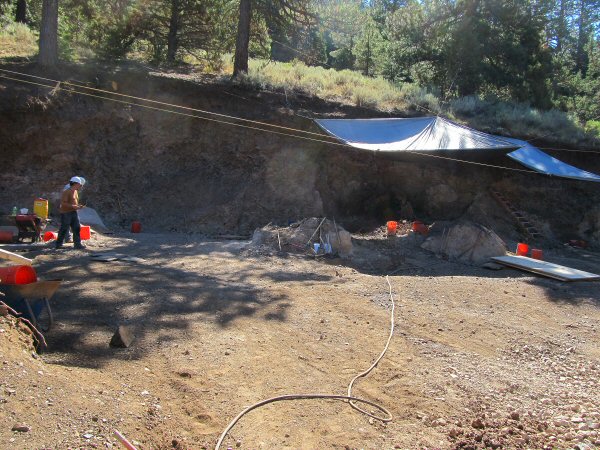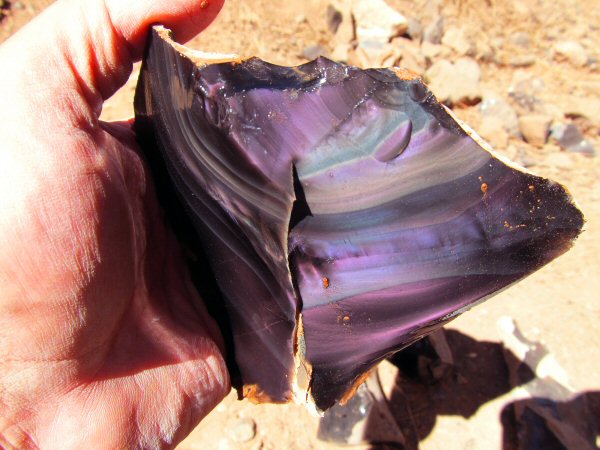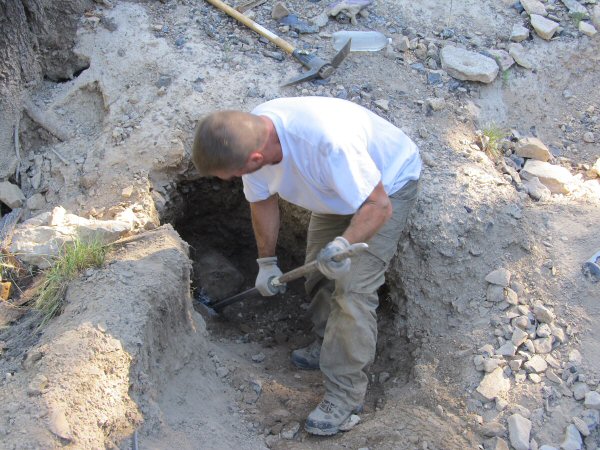
Editor’s note:For 2020 and perhaps longer, the obsidian sites mentioned in this blog, which are in the Modoc National Forest in Northern California are closed to collecting, while the Forest Service and other stake holders in the area decide how to best manage this resource. The Forest Service writes:
“More recently, commercial mining impacts have increased as overseas purchasers sought large quantities. This led to a number of unsustainable impacts to the resource, surrounding forest and nearby communities. Theft and illegal mining activities have increased substantially with evidence of heavy equipment, unauthorized roads, wildfire ignitions, unsafe mining practices, impacts on other forest users and an overall unsustainable removal of this non-renewable resource.
“We have the responsibility to insure this resource is available to tribal members for traditional cultural practices for generations to come and we appreciate providing this unique recreational activity for those who can use the resource sustainably,” said District Ranger Lisa Spahr. “We know it is a small percentage of users causing most of the issues, but the current situation has become unmanageable and we are forced to make the tough decision to put a moratorium on all collection until these issues can be addressed.”

My old rockhound buddy, Rollie Emerson, out of Susanville, California called me up out of the blue, and asked me if I wanted to go digging. I hadn’t heard from him in about eight years. “Well, let’s get one in for old time’s sake”, I said. “We aren’t getting any younger!” We chose to hit the Davis Creek Obsidian area in Northern California. Prior to arriving at the dig sites, Rollie and I stopped at the Davis Creek Store to get our free forest service permits. The casual rockhound is allowed to collect and keep 100 pounds per year. That’s roughly two 5 gallon buckets full – more than enough to play with.

At the Davis Creek rainbow area today, commercial mining is on the decline. Large, established commercial digs like the Broken Pick Mine above are a thing of the past. As always, it’s hand digging only at Davis Creek. No mechanization is allowed.

For safety reasons, the tall bank that you see in the back in this old photo has today been terraced by the Forest Service to cut back any dangerous overhangs.

Many trees were removed in the process of re-contouring the bank, so the area is much more open today and can get quite hot in the summertime.

According the the clerk at the Davis Creek Store, a few bad actors have been disrespecting the rainbow area, acting recklessly, and pilfering. In response, the Forest Service has installed a gate at the bottom of the spur going into the collecting area. I lucked out in 2018 – the gate had been opened for a gem and mineral club, and was not yet locked when I visited the site. So I could drive in, but apparently the gate is now usually locked which means you will have to carry out any obsidian you collect. The carry out is approximately two tenths of a mile, so it might be beneficial to bring a wheel barrow, or hand truck to carry out your obsidian (up to 100 lbs. only) unless you just like pretending you’re one of the characters in Dante’s Inferno!

A road that was illegally cut into the obsidian collecting area has been blocked by the Forest Service. This type of thoughtless behavior can only result in the area being closed to everyone. There are more and more land closures every year, so we all need to be responsible to help keep open what precious few opportunities to collect still remain. Please do your best to respect the land here and maybe our children and theirs will still be able to come here, collect material like grandpa and grandma did, and be enriched by the beauties of the natural world.

In this archival photo of the old commercial diggings, you can see about 6 feet of soil overburden has been cut through to get to the obsidian layer. An old obsidian miner friend of mine reported that they once got a 750 pound rainbow obsidian boulder out of the mine. How do you load a piece like that without any mechanization? “Brute strength and ignorance!” the old miner says.

Days gone by. In the past tons of obsidian had been transported by bucket load out of the area. Commercial miners would sell this material to rock shops, and cutting houses needing bulk amounts. I have gotten several calls from Chinese sourcers, looking to buy container loads of the coveted Davis Creek obsidian, but I have to tell them that I am a hobby digger, not a commercial miner, and the days of container loads are over.

Anxious to get digging, Rollie and I park at what used to be the tree covered separate public digging area. As noted earlier, this entire area has now been stripped of trees, and is a sun drenched, terraced bank about 30 feet tall. In this picture you can see one of the old tailings piles, at the far right.

Here, Rollie and I set in on a wall that has about 7 feet of exposure, getting us down through the soil overburden and putting us right on top of the obsidian layer. Not too bad! Rollie checks a piece of obsidian. We look to see if we can see visible striping on the outside of the rock, which indicates the presence of the rainbow flow bands within.

I work at the juncture of the floor and the wall, since that is where the zone turns from mostly dirt, to mostly obsidian cobbles.

Rollie mentions that there is obsidian in the soil overburden also, and sure enough, he soon uncovers a nice sized boulder.

Being more fluffy, the soil layer is easier to dig in, and Rollie quickly pulls down the boulder. But we’re not sure if it’s the prized rainbow or not. There is a mixed bag of obsidian present in this pit, and while some is bright rainbow, some is more black, some silver or gray sheen, and some is mahogany.

We’re in luck! A stroke of the rock pick flakes off an edge, revealing some nice banding of rainbow colors. We have to hold the rock at an oblique angle to get it to fire, but this can be helped by cutting, or doming the rock at a more parallel angle to the striping of the flow banding. An ideal angle is probably about 10 or 15 degrees offset from parallel. Please note that chipping or cracking obsidian is inherently dangerous. Obsidian breaks with razor sharp edges, and tiny needle sharp fragments can fly up into your face with great velocity. Always wear protective glasses when chipping or breaking obsidian.

Meanwhile, my dig looks like it’s going to produce a big rock!

I pull it out, and can see the color from a flake off the end.

Rollie holds a rock showing lovely pastel banding.

There are some awesome purple sheens coming out of this pit.

This rock had marvelous stripes of rich, vibrant color.

Here’s one that has purple stars that dance around on the surface.

The colors at the Davis Creek rainbow pit are electric. This is a premier gem obsidian. Rollie and I get a full bucket of great material.

A Davis Creek rainbow obsidian piece after windowing into a dome shape to capture the bullseye effect. Almost any piece you work on will yield an exquisite piece of natural art!

Interestingly, this and the previous piece are cut from the same rock, showing the color variations that come within a very short amount of space.

Because of pulses and movement in the original lava flows, you get these rippled banding effects that look like the Northern Lights.
Golden rainbow of light!

Beautiful teals and golds with a textured look.
Peppermint stripe.
The patterns are endless, and it ends up that there is not enough lifetime to get all the lapidary work done that there is to do out here!

On the way up to the Pink Lady mine, which is about another 8 miles uphill, we pass the famous Needle Hill digging area. This hillside yields intersting, long, thin shards of black and mahogany obsidian that look a little like knitting needles. Generations of rockhounds have dug here, but there is still material available. The needles have a tone when struck, and are often used by crafters to make nice, musical sounding windchimes.

The ground at Needle Hill is absolutely littered with black and mahogany obsidian cobbles. But there is no sheen obsidian here. There is one commercial pit on Needle Hill, but the hillside is big enough to accomodate a bus load of diggers, so there should be no problem finding a spot to dig. Rollie and I move on up the mountain however, anxious to locate the Pink Lady Mine.

It turns out that the Pink Lady is not so easy to find. It’s not visible from the Forest Service road, and you have to spur off on an unmarked dirt road that takes you back a few hundred yards to the digging area. After a few false chases down the wrong spurs, we finally find the area, which looks a bit like a moonscape with numerous craters. Obviously, a lot of work has been done here by generatons of rockhounds. There are good sized trees growing on some of the tailings piles. Rollie and I try to decide where to dig in.

Driven by some instinct that can’t be fully explained, Rollie burrows into the ashen white soil.

He’s got something, and it looks big. Tightly keyed into the rocky soil, it’s not moving.

But Rollie prevails and the Pink Lady yields up a boulder of pink sheen!

The thing I like about Rollie is the thing I like about most good rockhounds. He’s a generous person. Here, he lets me into his hole, since my luck seems to have run out, but his is running strong. You can see the large cavity that his boulder left, and there’s another good sized rock right below it.

You did say I could have this one right Rollie? Friend…old buddy…old pal?

I pull out a significant boulder. Not quite as big as the first one, but that’s OK, because I need my back to stay in one piece!

Nice soft pastel pink and gold sheens in the boulder from the Pink Lady Mine. Most certainly, there is more down in the pit, but it’s getting late, and it’s been an awesome day of beautiful sheen obsidian collecting.

Besides that, we have to leave something for the next person – That’s you! Yes you. So go ahead and turn off your device, Go get your permit, and get out there (Once the Forest Service decides to re-open the area). It’s waiting for you! Happy rockhounding!

